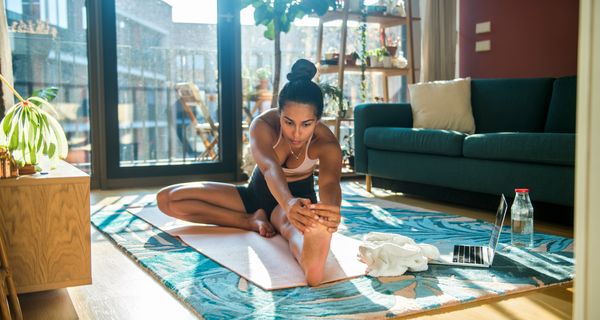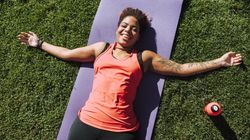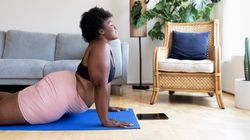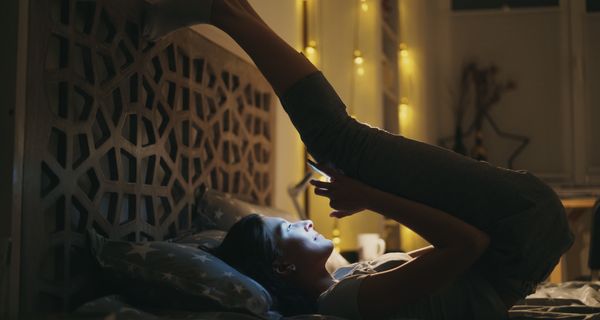Night owls are twice as likely to underperform at work than morning larks, a new study suggests, leading researchers to advise it’s important they adopt a healthy lifestyle, get enough sleep and work hours that suit their ‘chronotype’…
Tag: sleep
How To Boost Your Energy When You’re Just So Effing Tired
Why am I always tired? It’s a question we asked back in April 2020, when the pandemic first took hold – and we still relate. The days are exhausting, despite the fact we’re doing very little. Many of us are stressed, battling anxiety…
The Sleep Saboteurs: Why Staying Up Late Is Bringing Us Down
“I don’t put off going to bed, more going to sleep,” says Shirley*, 37, a researcher and administrator from South Wales. “I should go to sleep well before midnight to start work at 8 or 9 the following day. But I usua…
9 Habits That Can Drastically Improve Your Heart Health
On top of all the oft-cited lifestyle factors that increase the risk of heart disease, healthy habits and regular doctor visits may be slipping (understandably) during the coronavirus pandemic.While this feels pretty grim, there is a bright side: Some…
A 10-Minute Wind Down Routine Can Help You Beat Sunday Blues
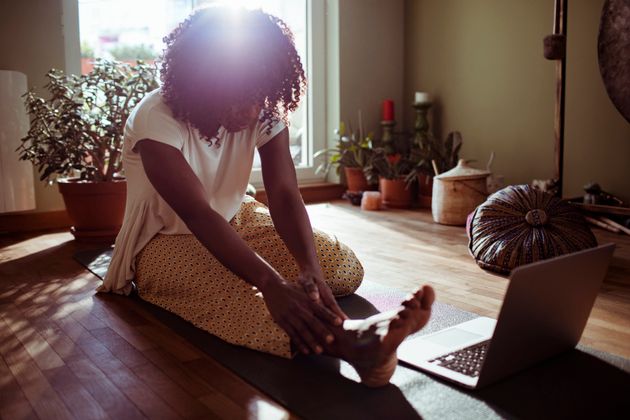
You’re reading Here, Try This – our month-long plan encouraging you to try something new every day.
We all know having a screen-free, relaxing bedtime routine is the best way to get a good night’s sleep – especially when life makes it’s hard to switch off. So, just as a 10-minute morning routine can start your day off right, a short stretch before bed is a great way to let your body know that sleep is on its way.
London-based yoga teacher Annie Clarke, who runs online yoga studio The Practice, says often we finish our days without much pause or opportunity to switch off before bed. Or, she says, we use evenings to workout, which is great, but narrows the window between our “high energy activity” and trying to sleep.
“By making time for a slow yoga practice such as yin or restorative yoga, we can encourage the transition from the ‘fight or flight state’ in which many of us operate during the day to the rest and digest ‘mode’ that helps us settle into much needed restful sleep,” she tells HuffPost UK.
“Even something as simple as a few minutes of breathing can help the body and mind make that transition, signalling to our nervous system that we are safe – and that it’s ok to let go.”
10 minutes of Yin-inspired poses to relax body and mind:
Yin yoga positions are typically held for around four to 10 minutes per pose, says Clarke, but this is a shorter sequence you can try to support restful sleep.
1. Calming breath – one minute
“Find a comfortable place to sit, either crossing the legs or sitting back onto your heels. Lengthen the spine and soften your gaze or close your eyes. Take a few breaths without trying to change the breath at all. Then begin to breathe in for a count of four and out for a count of four. You can continue to breathe 4:4 or lengthen the exhale to six or eight.”
2. Caterpillar pose – three mins
“Sit down with your legs extended out in front of you. You can sit on a cushion or rolled up blanket to support you. Let the upper body relax forward over the thighs. Don’t worry about how far you fold, think more about how much you can soften. If it is uncomfortable for the neck, you can place a bolster or a big cushion underneath your head, which can also further encourage activation of the parasympathetic (rest and digest)nervous system.”
3. Spinal twist – two mins each side
“Lie with your back on the floor and your knees bent. Push into the feet to move your hips an inch or two to the right and then let your knees drop to the left. You can place something under the knees if it feels too strong on the lower back. You can extend your arms out in line with your shoulders to make a T-shape and look to the opposite side or the same side as the legs, depending on what feels better in your body. Gently come back to the centre when you’re ready, pausing with the hips in the middle of the mat before swapping to the other side.”
4. Savasana – two mins
“Lie down on the back of the body. You might like to cover your body with a blanket, or place a rolled up blanket or bolster under your knees. Let the legs lengthen onto the floor with at least a hips-width gap between the heels. Let your arms rest away from the sides of your body so there is space under your armpits. Close your eyes and let go.”
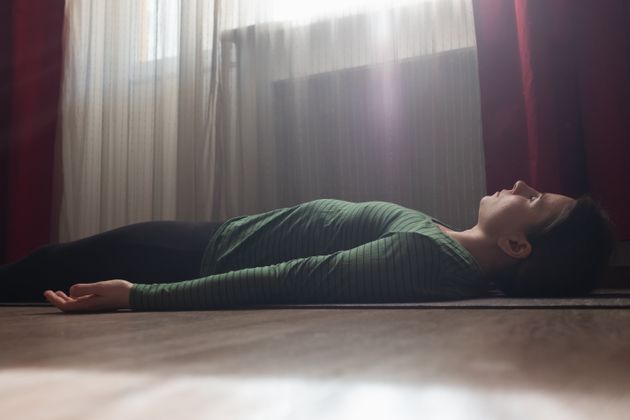
If you enjoy doing a pre-bedtime routine and want to mix it up, Becca Young Riboldi, instructor at Fly LDN, has another sequence you can try.
10 minutes of flow to ready yourself for a good night’s sleep:
This is a pre-bedtime flow but don’t expect a heart racing workout, says Young. “We will get the body moving in restorative ways in order to combat WFH pains and prepare yourself for a nurturing night’s sleep.”
1. Belly breaths – 30 seconds
“Come into a comfortable seat, legs crossed, and rock yourself side to side until the sit bones sit nicely on to the ground. Rest your hands on your knees, let your shoulders relax and breathe deeply into your diaphragm through the nose. On every exhale imagine your shoulders softening down your back.”
2. Neck rolls – one minute
“Maintain your seat and let your left ear drop to your left shoulder, hold for a couple of breaths, and then turn your gaze down the floor, again holding for a breath or two. Inhale to raise your head back to centre and repeat on the right side. Finish by letting your chin fall to your chest and turning your head gently from side to side.”
3. Cactus arms – one minute
“Switch the crossing of your legs and sit up nice and tall. As you inhale stretch your arms overhead, and reach up towards the sky, palms facing forward. As you exhale ‘cactus’ or bend the elbows into your sides, squeezing your shoulders together behind you, tilting your chin up slightly. Repeat this 10 times and move with your breath.”
4. Spinal twists – 30 seconds each side
“Inhale to extend arms back overhead, keep shoulders down and away from the ears so your neck is nice and long. Bring your left hand to your right knee while your right hand falls onto the floor behind you, and take your gaze over your right shoulder. Sit up nice and tall as you inhale and twist through belly as you exhale. Hold this for about eight breaths before reaching arms back up to the sky and repeating on the other side.”
5. Cat-Cows – one minute
“Come into a tabletop position, grounding your hands underneath shoulders, knees underneath hips. Inhale as you let your belly drop, lift your gaze and squeeze your shoulders together. Exhale as you push into your hands, round your spine, engage your belly and feel a separation between your shoulder blades. Flow through these two movements, using the breath to guide you.”
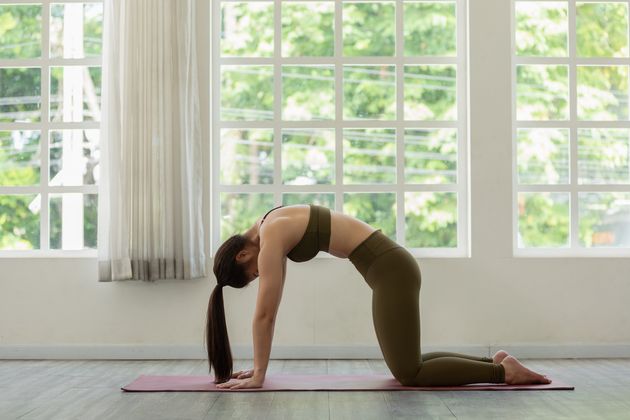
6. Shoulder rotations – 30 second each side
“Maintaining your tabletop, reach your right arm up towards the sky and open your chest. Begin to rotate into your shoulder, reaching your arm towards the back of the room, down along the floor, all the way forward and then back up towards the sky. Engage your belly and repeat this five full times slowly in one direction and then go the other way. Once you are done with your right side repeat this on the left.”
7. Needle and thread – 30 second each side
“Reaching your right arm back up towards the sky, open the chest and then thread your right arm underneath your left, dropping your right shoulder and cheek to the ground. Press into your left palm to lift your chest and arm up and open again. Repeat this 3 times before settling your right shoulder down to the ground and holding, possibly walking your left fingers toward the front of the room to deepen the stretch. Rise back to tabletop and repeat on your left side.”
8. Puppy dog pose – one minute
“From your tabletop walk your hands forward one big step and begin to lower your chest and forehead down to the ground. If your head doesn’t quite reach the floor you can use a pillow to rest it on. The important thing here is to keep your hips stacked over your knees and feel the stretch into your shoulders and upper back.”
9. Shoulder stretch – one minute
“Move your hips back to your heels so that you are sitting upright on your shins. Begin to interlace your hands behind your back, bringing the palms to touch if possible and straightening out through the elbows. Relax the shoulders down and lift the chest. Begin to lower your belly towards your thighs and continue to lift your fist away from your lower back. Once your forehead reaches the floor you can stay here or – if no neck problems – roll onto the crown of the head and let your fist drop forward for a deeper stretch. Breathe deeply.”
10. Child’s pose – one minute 30 secs
“Time to digest all of that good movement. Spread your knees nice and wide – a bit wider than your hips – bring your big toes to touch and sit your hips to your heels. Reach your arms forward as you lay your belly down between your thighs. Feel the back, shoulders and hips softening, let your neck be totally loose, and breathe deeply, calming the nervous system and setting yourself up for a restorative night’s sleep!”
This new year, we focus on fun, not denial (because we’ve all had enough of that). Follow our month-long plan, with a new Here, Try This idea each day, spanning easy ways to engage your body and mind, inspiration for your food and home, and tips for boosting how you feel – inside and out.
Wolf Moon: The Full Moon Really Could Be Messing With Your Sleep
As the so-called Wolf Moon approaches, you might find you’re not getting as much shut-eye as you’d like. But don’t worry, on this occasion it’s probably not because of the pandemic or work worries. You can blame the full moon.
A new study has found that in the days leading up to a full moon, people go to sleep later in the evening and sleep for shorter periods of time – regardless of whether they live in cities or the countryside. Researchers believe this may be due to increased light exposure, however other studies suggest humans are simply attuned to the moon’s cycle.
The next full moon in the UK is on Thursday January 28 and will appear for roughly three nights. This winter moon is known colloquially as Wolf Moon, it’s thought because wolves used to be heard howling at this time – whether from hunger or to bond with the pack.
But back to your sleep! What else do you need to know?
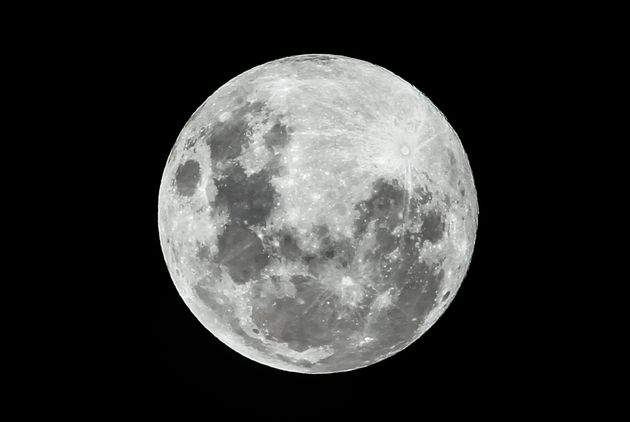
Human sleep cycles oscillate during the 29.5-day lunar cycle, the paper published in Science Advances revealed. This may indicate our natural circadian rhythms are synchronised with, or entrained to, the phases of moon.
A research team, led by Professor Horacio de la Iglesia, an expert in biology from the University of Washington, observed later bedtimes and shorter sleep periods in urban and rural settings.
Using wrist monitors, the team tracked sleep patterns among 98 people living in three Toba-Qom Indigenous communities in the Argentine province of Formosa. One rural community had no electricity access, a second rural community had only limited access, while a third community lived in an urban setting with full access to electricity (and therefore artificial light).
For nearly three-quarters of the Toba-Qom participants, researchers collected sleep data for one to two whole lunar cycles. They saw the changes in sleep patterns regardless of an individual’s access to electricity, though the variations were less pronounced in city dwellers.
“We see a clear lunar modulation of sleep, with sleep decreasing and a later onset of sleep in the days preceding a full moon,” said Prof de la Iglesia.
“And although the effect is more robust in communities without access to electricity, the effect is present in communities with electricity, including undergraduates at the University of Washington.”
Past studies by Prof de la Iglesia’s team and other research groups have shown access to electricity impacts our sleep, as also evidenced in this study. Toba-Qom in the urban community went to bed later and slept less than rural participants with limited or no access to electricity.
But participants in all three groups showed the same sleep pattern changes as the moon progressed through its 29.5-day cycle. The total amount of sleep varied across the cycle by an average of 46 to 58 minutes, while bedtimes changed by around 30 minutes. On average, the latest bedtimes and shortest amount of sleep came in the three to five nights leading up to a full moon.
The team analysed sleep-monitor data from 464 college students in Seattle that was collected for a separate study – and found a similar pattern. The evenings leading up to the full moon have more natural light available after dusk – and it might be this light that’s keeping us up, researchers suggested.
The patterns could be “an innate adaptation that allowed our ancestors to take advantage of this natural source of evening light,” said lead author Leandro Casiraghi. The brightness of the moon might also explain why electricity causes such pronounced changes to our sleep patterns, Prof de la Iglesia added.
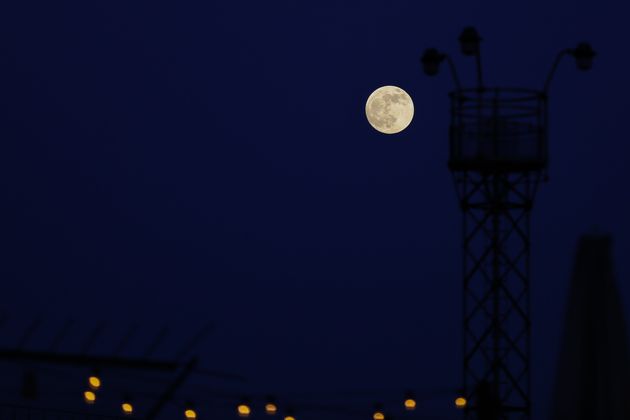
“In general, artificial light disrupts our innate circadian clocks in specific ways: it makes us go to sleep later in the evening; it makes us sleep less. But generally we don’t use artificial light to ‘advance’ the morning, at least not willingly. Those are the same patterns we observed here with the phases of the moon.”
There’s been “a lot of suspicion” around the idea that the phases of the moon could affect sleep, acknowledged Casiraghi. “Future research should focus on how: is it acting through our innate circadian clock? Or other signals that affect the timing of sleep?” he said. “There is a lot to understand about this effect.”
Dr Andrew Bagshaw, of the Centre for Human Brain Health at the University of Birmingham, tells HuffPost UK the latest study is “interesting” – particularly the participation of different communities to understand the universality of human relationships with the lunar cycle.
“Their hypothesis that this prolonged oscillation in sleep patterns linked to the lunar cycle is driven by access and exposure to light makes sense,” he says. “We know that variation in sunlight during the 24-hour light-dark cycle is the most potent determinant of sleep patterns generally.
“The more subtle variation in light exposure over the course of the lunar cycle might also be expected to have an impact on sleep patterns, as they have found. The fact that the effect is less pronounced in urban dwellers, where there is likely to be less access to moonlight, would fit with this idea.”
He adds the caveat that moonlight contains less blue than sunlight – and blue light is thoughts to have the largest impact on circadian rhythms and therefore sleep. “It is possible, in addition to light exposure, the effect could be the result of the many molecular processes in the body that are impacted by the lunar cycle,” he says. “There are plenty of issues still to understand!”
A study from 2013, published in the journal Cell, found similar results, only with research undertaken in controlled laboratory conditions – meaning study participants weren’t kept awake by bright light in the evening. Researchers analysed sleep structure, brain activity during non-rapid-eye-movement sleep, and secretion of melatonin and cortisol in volunteers.
Around a full moon, deep sleep decreased by 30%, the time to fall asleep increased by five minutes, and sleep duration reduced by 20 minutes.
Here’s Scientific Proof That Afternoon Naps Are Good For You
Taking that regular afternoon nap you’re craving may be linked to better mental agility – surely the cue we’ve all be waiting for to grab a blanket and 40 winks.
Nodding off is associated with better awareness of your surroundings, improved verbal fluency and a sharper working memory, a new study published in the online journal General Psychiatry has found.
Our sleep patterns change as we age, meaning we’re more likely to nap during the day. But research to date hasn’t reached any consensus on whether these naps might stave off cognitive decline and dementia in older people – or are a symptom of it.
So researchers explored this in 2,214 ostensibly healthy people aged at least 60 and living in large cities around China, including Beijing, Shanghai, and Xian.
In all, 1,534 took a regular afternoon nap, while 680 didn’t. All participants underwent a series of health checks and cognitive assessments, including the Mini Mental State Exam (MMSE) to check for dementia. The average length of night time sleep was around 6.5 hours in both groups.
People were asked how often they napped during the week. Afternoon naps were defined as periods of at least five consecutive minutes of sleep, but no more than two hours, all of them taken after lunch

The screening tests included 30 checks that measured aspects of cognitive ability, and higher function, including visual-spatial skills, working memory, attention span, problem solving, locational awareness and verbal fluency.
The MMSE cognitive performance scores were significantly higher among the nappers than they were among those who didn’t nap. And there were significant differences in locational awareness, verbal fluency, and memory, too.
As an observational study, it can’t establish cause. And the exact duration or timing of the naps was not recorded.
One possible explanation for the results, say the researchers, is that inflammation is a mediator between mid-day naps and poor health outcomes – inflammatory chemicals have an important role in sleep disorders, note the researchers.
Sleep regulates the body’s immune response and napping is thought to be an evolved response to inflammation – meaning people with higher levels of inflammation also nap more often, explain the researchers.
Covid Has Thrown Off Bedtime Routines. Here’s How To Get Back On Track
For almost a year now, the pandemic has eroded many families’ sleep routines. Bedtimes have crept later and later, kids have gotten in the habit of crawling into their parents’ beds, and sleep physicians report their offices (or o…
The Funniest Tweets About Trying To Share A Bed With Your Partner
Trying to get a good night’s sleep when you’re coupled up is no easy feat.
You have to contend with a whole host of annoying habits and potential sleep disturbances: snoring, loud breathing, blanket-stealing and snoozing the alarm far too many times, just to name a few. Somehow, the spouses of Twitter are able to find the humour in the most irritating of circumstances.
Below, we’ve rounded up 33 hilariously accurate tweets about sharing a bed.
No matter how hot the night is, never underestimate how cold your wife’s feet will be when she puts them on your back.
— Crockett🍀 (@CrockettForReal) August 25, 2019
1.
My husband rolled over and open mouth snored directly into my eyes last night if you’re wondering how we keep the magic alive.
— Maryfairyboberry🧚🏻♀️ (@maryfairybobrry) December 11, 2019
2.
DATING: can’t wait to see you again
MARRIAGE: part of your knee was on my side of the bed again last night
— mark (@TheCatWhisprer) August 21, 2020
3.
Sleeping under separate blankets should have been the marriage advice everybody gave me a year and a half ago.
— Ashley C. Ford (@iSmashFizzle) January 27, 2020
4.
I found the couch blanket on the bed again. My husband must think I’m playing. Three strikes and you’re out, buddy.
— Darlin’ Darla (@Darlainky) December 4, 2019
5.
Get married and spend the rest of your lives trying to figure out what to do with your arms while you sleep.
— Aunt Chelle 😷 ☕️✊🏽 (@ravenswng_) May 17, 2019
6.
Me: [giving my husband a tutorial on how to put the throw pillows on the bed]
Him: I don’t want to be an adult anymore— Anna Grace (@graceupongracie) July 30, 2019
7.
Wife’s traveling so this morning I apologized to her pillow for stealing her blanket
— Vinod Chhaproo (@Chhapiness) October 16, 2019
8.
Who needs a gym, I can get a full workout trying to wriggle my way under my wife’s weighted blanket for some cuddle time.
— Jester D 🐢🧡🌎 (@JustMeTurtle) April 18, 2020
9.
Snoring dog=loving affection
Snoring husband=seething rage— jan (@JJSummertime) February 17, 2019
10.
After 22 years my best marriage advice is don’t marry someone who sets his two phones and alarm clock to go off at 5min intervals and then always hits snooze for at least an hour.
— 🇺🇸E.🇺🇸 (@YourMomsucksTho) September 3, 2018
11.
First comes love, then comes marriage, then comes-
-the reality that you unknowingly married someone who insists on keeping the keyboard sound on as he texts in bed each night.
— Stephanie Ortiz (@Six_Pack_Mom) August 25, 2019
12.
Woke up at 3am because I fell asleep in a recliner and my spouse went to bed and just left me there. So I crawled to bed and arranged the pillows to really constrict my airflow to make sure I snored the rest of the night.
— Betty 🪡🫒 (@BoomBoomBetty) July 7, 2019
13.
If I figure out how to put this duvet cover on by myself this marriage is in serious trouble.
— PRESIDENT BIDEN (@MommaUnfiltered) December 9, 2018
14.
Hello did your husband get up at 1:30 am and loudly do the dishes and use kitchen appliances because he couldn’t sleep? Then you might be me and you might be entitled to compensation.
— Eli McCann (@EliMcCann) January 18, 2021
15.
Shazam’d my wife snoring last night and it came up as Bob Dylan lol.
— FᎪᎢ ᏩᎪNᎠᎪᏞF (@sofarrsogud) November 27, 2019
16.
My wife texted me from the bedroom last night saying she ate crackers in bed and she needed help changing the sheets because crumbs were everywhere.
Turns out that was not an excuse to get me in the bedroom for sex. She literally ate crackers like our 4 yo.
— Dadman Walking (@dadmann_walking) September 26, 2019
17.
My husband fell asleep without saying goodnight so I woke him up to say “you didn’t say good night to me, that’s bad luck!” In case you’re wondering what being married to me is like
— josie duffy rice (@jduffyrice) January 15, 2019
18.
Marriage is calling 8 inches of a California King size bed “the husband zone.”
— Crockett🍀 (@CrockettForReal) August 25, 2019
19.
[lying in bed]
Me: hope I can get to sleep. so many things running through my head.
Husband: i know. i feel the sa…
Me: huh? hello?
Husband: *snoring*
Me: jfc.
— Mummy Dear (@ThatMummyLife) March 30, 2020
20.
I’m going to meet my husband at the finish line of his 10-mile trail race so I can tell him how I never fell back to sleep after his alarm went off this morning.
— Amy Dillon (@amydillon) December 2, 2018
21.
NEWLYWED: what’s mine is yours
VETERAN SPOUSE: don’t use my pillow again— mark (@TheCatWhisprer) August 15, 2017
22.
Things My Husband Sleeps Through:
-Crying Babies
-The Purge
-Conversations
-Explosions
-Fighting Kids
-Chores
-Sonic Booms
-The Zombie Apocalypse
-Animal Stampedes
-My Jokes
-Natural Disasters
Things that Awaken my Husband:
-The mererest whisper of Sex.— Maryfairyboberry🧚🏻♀️ (@maryfairybobrry) September 5, 2019
23.
Being the first to fall asleep at night is such a marriage flex.
— Simon Holland (@simoncholland) August 12, 2020
24.
Sometimes when my husband is sleeping soundly next to me I like to turn his phone’s sound on and send him a text asking, “are you awake?”.
— The Evolving Arm (@leftarmisme) December 19, 2020
25.
Friend: My husband sets his alarm 30 minutes early so we can cuddle in the morning.
Me: My husband lets me sleep because he values his life.
— Jawbreaker (@sixfootcandy) July 16, 2018
26.
Edging in marriage is just how much blanket your spouse allows you to have each night.
— Betty 🪡🫒 (@BoomBoomBetty) November 2, 2018
27.
Every night my wife wakes me up and whispers the magic words, “You’re sleeping on my pillow, asshole”
— Vinod Chhaproo (@Chhapiness) August 24, 2020
28.
Me: I can’t fall asleep at night
Doctor: Okay, right after you lay down for sleep, ask your wife how her day was and that should fix it
— Chad Read (@squirrel74wkgn) February 5, 2020
29.
My wife does this really cute thing where she talks in her sleep and tells me how much she loves me.
So I always whisper back, “Awesome. We need a bigger TV,” cause inception is real folks.
— dADDisms (@Beagz) October 25, 2019
30.
Me asleep with an imperceptible nose whistle, wife makes me go to the guest room.
The dog snores, farts, growls, and drools on the pillow, wife makes him the little spoon.
— Bart (@bartandsoul) August 17, 2019
31.
Wife: let’s try something new in bed 😉
Me: say no more 😏
*we swap sides and fall asleep immediately*
— Quilliam (@nyquills) June 28, 2019
32.
The husband & I just debated my “excessive” use of throw pillows on our bed, in case you wondered what 19 yrs of marriage looks like.
— Stephanie Ortiz (@Six_Pack_Mom) February 20, 2019
33.
What To Eat Throughout The Day To Get A Good Night’s Sleep
Whether it’s overall stress, anxiety related to the coronavirus or other factors, many of us just aren’t sleeping well. Pinpointing the exact cause can be tough, but sometimes the problem — and the solution — are right on your plate or in your cup.
There’s undoubtedly a link between the drinks and foods consumed throughout the day, especially closer to bedtime, that can result in tossing and turning. HuffPost consulted with dieticians to learn more about what foods to eat (or avoid) for a more restful night.
Though no particular food is a magic cure, there are certain food groups or properties that are beneficial to overall health. It’s also important to note that while everybody may need a different amount of sleep (as much as 10 hours or as little as six), many experts define sleep as “good” if it results in you waking up feeling rested.
Look for foods that are high in melatonin
Melatonin is a natural hormone that’s sometimes referred to as the sleep hormone.
“Melatonin is a hormone that your brain produces in response to darkness. It helps with the timing of circadian rhythms and with sleep,” registered dietitian nutritionist Shana Minei Spence told HuffPost.
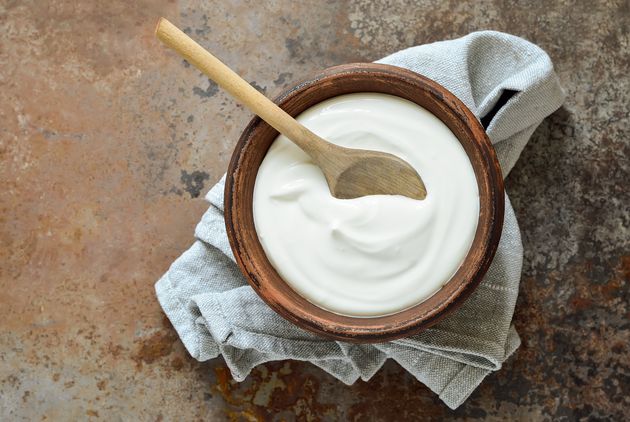
Though melatonin is produced in the body, you can also consume foods that contain it, like almonds, which you can snack on throughout the day.
And then there’s tryptophan. Foods like cottage cheese and plain yoghurt also contain tryptophan, which increases the production of melatonin and can help you get a good night’s sleep, Spence said.
There’s no real magical hour to consume melatonin, but “the more you consume, the greater effect it will have,” she told HuffPost.
If you’re consuming a large portion of melatonin-rich foods or taking a supplement, Spence recommends waiting at least an hour or 30 minutes before going to bed, respectively, which is the amount of time it takes for the melatonin to have an effect on the body.
Look for foods that contain magnesium
Similar to melatonin, magnesium is another winner when it comes to catching more Zzzs.
“Magnesium’s role in promoting sleep is thought to be related to its ability to reduce inflammation. Additionally, it may help reduce levels of the stress hormone cortisol, which is known to interrupt sleep,” Spence said.
Some studies have estimated that up to 75% of Americans are actually magnesium deficient. However, loading up on magnesium-rich foods isn’t too hard, as it’s found in leafy greens, almonds, peanut butter, flax and sunflower seeds.
Kylene Bogden, a registered dietitian-nutritionist and wellness adviser for Love Wellness, calls magnesium “nature’s sleep aid.”
Bogden’s go-to is a hearty Buddha bowl that contains “your favourite nuts, seeds, legumes, greens and tofu.”
“It’s the absolute best and easy-to-digest dose of magnesium for dinner,” she said.
Eat whole foods, not processed foods
Whole foods, which are typically defined as being minimally processed and packed with fibre, are another food category to consume from throughout the day so your stomach is happy at night.
“Whole foods, including complex carbohydrates that are slower digesting, can help keep the body balanced in this way,” said Celine Beitchman, director of nutrition at the Institute of Culinary Education.
These foods contribute to overall, balanced nutrition and ultimately prove helpful when it’s time to hit the hay. They help settle the digestive system, while sugary or overly processed meals can lead to spikes in blood sugar.
A few options that Beitchman recommends include a breakfast consisting of whole grain porridge with dried or fresh fruit and toasted nuts, or eggs with 100% whole grain bread.
For lunch or dinner, try a pan-seared salmon with bulgur pilaf, which is also packed with magnesium. The fish can easily be swapped out for tofu, tempeh or seitan to make the meal vegan.
Drink a warm, caffeine-free beverage before bed
Bogden recommends drinking a cup of chamomile tea, calling it an “all-natural sleep aid.” But there’s another nighttime beverage she loves.
“I swear by golden milk, a turmeric-based almond milk with dates, as a sweetener,” she said.
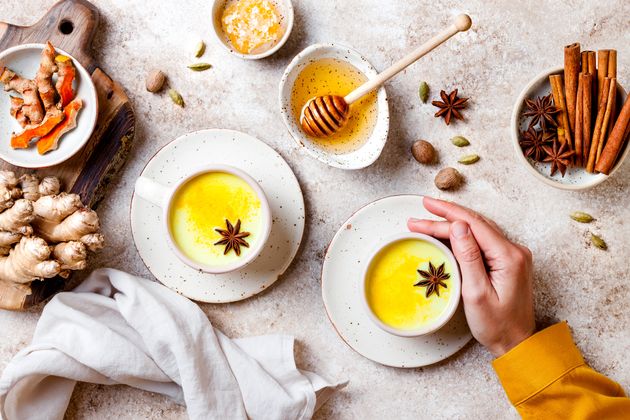
The drink — which is traditionally made with either cow’s milk or plant-based milk — gained popularity among the Western world a few years ago. Turns out, it’s quite beneficial to sleep.
“Turmeric is a powerful, anti-inflammatory spice that promotes a sense of calm and aids in digestion, thereby enhancing sleep quality,” Bogden said.
However, she recommends keeping the drink plant-based.
“Cow’s milk can be extremely inflammatory for some, leading to gas and bloating ― not ideal before bed,” she said.
All of the experts agree that it’s not just what you eat, but also when you eat.
“Allow two hours or more between your last bite of food and bed, no matter what you choose to eat, and one hour before when it comes to beverages,” Bogden said.
And Beitchman suggests spacing your meals four to five hours apart so your body has time to digest the food.
Stay away from caffeine
That late-afternoon cup of coffee might just have you tossing and turning in the middle of the night and into early morning.
“Caffeine — coffee, soda and chocolate — should be stopped for at least four to six hours before going to sleep. Caffeine can stay in the system for up to 12 hours,” Spence said.
Also, if you think you’re playing it safe by consuming a decaffeinated beverage, think again.
“Decaffeinated still has caffeine,” she said. “The stimulant effects can keep you up at night.”
Avoid alcohol
Sipping on a glass of wine or downing a few beers to relax in the evening can end up hurting you.
“Most people look to a night cap in order to sleep better, when in fact alcohol before bed can impair sleep quality,” Bogden said, noting that while alcohol might make us fall asleep, it disrupts our REM cycle, “otherwise known as the most restorative component of our sleep cycle.”
Bogden said she asked her clients to use a smartwatch to track their sleep, and they all found that when they cut back on alcohol before bedtime, they experienced less movement and instances of waking up at night.
Keep spicy foods to a minimum
“Spicy foods can be irritating as they work their way through your digestive system,” resulting in discomfort or even pain as the food moves through your gastrointestinal tract, Beitchman said.
However, that doesn’t mean you have to swear off spicy foods altogether.
“Just make it a part of the plate, not the dominant feature,” to achieve optimal sleep, Beitchman said.
Should You Try A Sleep Workout? It’s The Latest Bedtime Trend
With 2020 being the year our sleep officially took a turn for the worse, it’s unsurprising so many of us are turning to Pinterest for sleep inspiration.A 2021 trends predictions report from the social media site says there’s been a 90…
